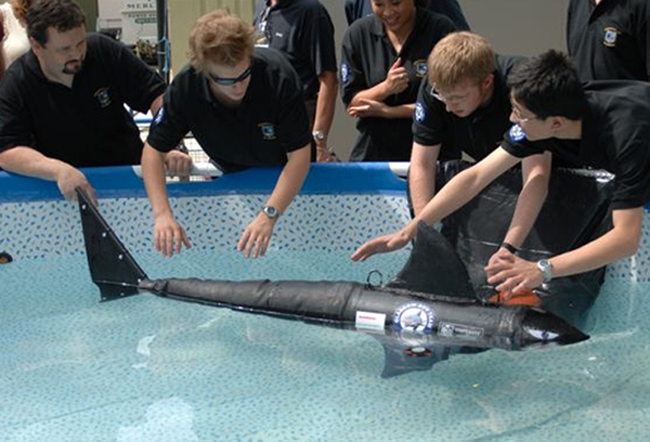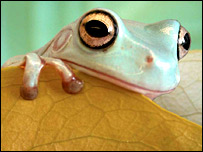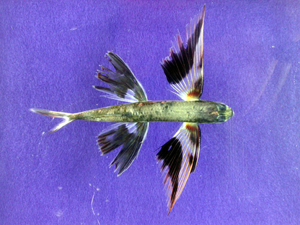RoboSalmon discussions and research
Introduction
This story suggests lots of topics for discussion and research.
Take a look at those we've picked out from the text. Compare ours with those you found using the methods in Getting the topics.
In your groups, discuss the differences. This isn't about right or wrong. Your choices are as good as ours, as long as you can explain and defend them.
Now have a go at some of the topics - ours or yours.
Help with words
After each film clip we explain some of the harder words the researcher uses - and some of the words used in these explanations.
Just mouseover words in any of the lists to get their meaning.
(Resources on this page sponsored by Glasgow University Science Festival.)
Selected topics
Learning lessons from nature is what biomimetics is all about.
Oil companies use them to inspect and repair ... Navies employ them ... Scientists study subsea life ... using a wide variety of vehicles.
They are inefficient at low speeds, so they use more energy than a fish does.
All this suggests lots of possible applications.
Salmon would often shoot straight up the ladder, but at times they would sit at the bottom for days on end. Nobody knew why.
You could have robot goldfish as pets. If you put a solar cell in them they could swim around on your desk forever.
Want more?
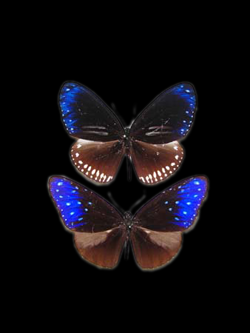
Learning lessons from nature is what biomimetics is all about.
Meet Chris Woods, a PhD student in Euan McGookin's team, and the person who actually put RoboSalmon together "out of stuff bought from B&Q and Maplin's".
[Words: prototype, systems, budget, electronics, engineer, construction, fibreglass, moulding, PVC]
Biomimetics is a new field of engineering with lots of exciting things happening - at Glasgow University and elsewhere around the world. Let's take a look first at the word itself.
Mimetic just means acting like or imitating. It's the same sort of word as mime and mimic.
Now working in groups see how many words you can think of that begin with the letters bio. When you've got a few take a look at a dictionary or use a computer to get your list up to a dozen different words. Have a chat in your groups and try to work out what these words have in common.
See if you can find out which one word the bio in all these English words comes from. What language did it belong to and what did it mean?
Where is the word used nowadays in a way no one could have imagined? What's the connection between the meanings then and now?
So now what does biomimetics mean?
Have a listen to how biomimetics came into what Chris was doing - how he combined lessons from nature with engineering.
[Words: prototype, limitation, incorporated, design, development, ballast, initial, distribute, control, buoyancy, dive plane, ballast tanks, caudal fin, propel, turning moment, efficient, propulsion, benefit, rudder, manoeuvrability, mimic]
In groups put together a list of things Euan and Chris have taken from nature - from how fish do it - and used in their robot fish. Listen to what the researchers say and use what you can see for yourself.
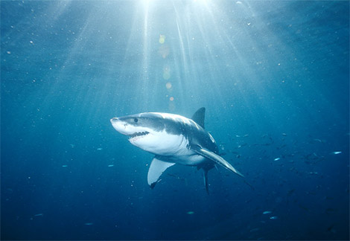
Imagine you are one of the team of engineers. In your groups discuss and decide why you included these things in RoboSalmon or SHARC. (As an engineer you're interested in practical questions like: How important is this? Can we actually do it? Can we do it in the time we have, and for the money we've been given? Will it make a big difference if we don't include it in our model of the real thing?)
Now put together another list of things that real fish have or can do that the robot can't. Discuss and decide why you think the engineers did not include these in RoboSalmon or SHARC.
[More words: model, device, electron, fundamental, electric charge, particle, attract, repel]
Oil companies use them to inspect and repair ... Navies employ them ... Scientists study subsea life ....using a wide variety of vehicles.
The variety is enormous. But you can get a handle on what it's all about by noticing that underwater vehicles usually belong to one of two types - remotely operated vehicles (ROVs) or autonomous underwater vehicles (AUVs). A few really modern vehicles can be either, but that's very unusual.
Have a quick look at some of the vehicles out there by clicking on the images in this section and exploring the websites they take you to.
Now answer this question. What is the key difference between an ROV and an AUV?
Have a chat and say why you think ROVs have been around longer than AUVs and there are many more of them.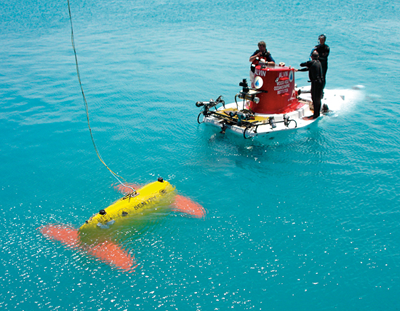
In groups choose one of the two main types of vehicle - ROV or AUV - and put together a list of as many different appplications as you can find for your chosen type.
Get together with a group that has chosen the other type and compare your lists. Count how many applications appear in both lists and how many appear in only one.
As a group come up with an explanation for what your result shows, based on the key difference between the two types of vehicle.
Choose an application of an ROV or AUV that appeals to you. Put together a short presentation with images - and brief video clips if you like - taken from one or both of the sites we link to in this section. Your own words should pull the images together into an interesting story.
One last question for this section: Is RoboSalmon an ROV or an AUV? What decides?
They are inefficient at low speeds, so they use more energy than a fish does.
 Have a listen to what Euan has to say about why even torpedo-shaped vehicles - which are nice and streamlined and look good at getting through water - are inefficient at low speeds.
Have a listen to what Euan has to say about why even torpedo-shaped vehicles - which are nice and streamlined and look good at getting through water - are inefficient at low speeds.
[Words: inefficient, drains, energy, rotate, overcome, continual, efficiency
Let's look at this idea of efficiency, which propellers don't have at low speeds but fish do. It's one of the most useful ideas in engineering. And it's a simple one.
Efficiency is just a number that tells us how much work a machine is doing, compared to the amount of energy we're putting into it.
So if a machine is 50% efficient, then half the energy that goes in does useful work. The rest is wasted, usually as heat.
Power stations like that one on the right, for instance, are only about 35% efficient. So two-thirds of the energy from burning coal, oil or gas is lost. You can see it in the picture. That's not just steam that's going into the air and doing nothing useful. It's heat. It's energy.
The electric light bulbs that are gradually being replaced in our houses are even less efficient - only about 2%. So ninety-eight out of every hundred bits of energy that go into the bulb as electricity come out as wasted (and painful if you're too quick to change an old bulb) heat.
Remember the big difference between an autonomous underwater vehicle (AUV) and a remotely operated vehicle (ROV) from the last section?
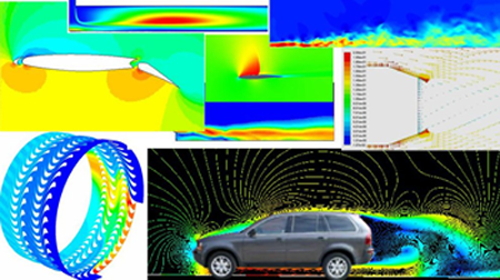 An AUV doesn't have a cable - sometimes called a tether or umbilical.
An AUV doesn't have a cable - sometimes called a tether or umbilical.
The cable on an ROV does two things. It carries messages between the human operator and the vehicle. So an ROV doesn't need a brain.
But it also carries electrical power. So an ROV doesn't need a battery.
An AUV is on its own. So it needs to be smart and it needs to have energy. The battery is vital to an AUV. The longer the battery lasts, the more work it can do before coming back for a new one.
Listen again to Euan and find the phrase that connects the efficiency of an AUV with how long its battery lasts.
In your groups put a sentence together to explain this connection.
Now let's take a quick look at a machine you're more familiar with. A car engine is about 35% efficient. So just over a third of the energy in petrol could come out as useful motion.
But that's in perfect conditions. And it's only talking about the engine. In normal driving only about a tenth of the energy in petrol is turned into motion of the car.
Have a discussion and make a list of all the wasted forms of energy a motor car produces from petrol, besides the energy of motion.
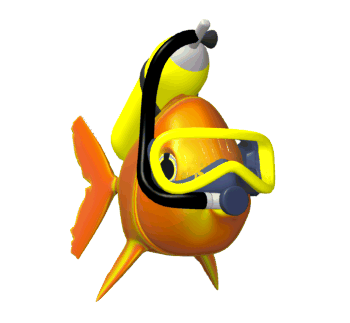
Now have a discussion and make a list of all the wasted forms of energy an underwater vehicle produces, from its battery, besides the energy of motion.
Finally have a listen to Euan talking about the efficiency of RoboSalmon and have a go at these questions:
Suppose a battery in a propeller-driven AUV lasts twenty days. How much longer would a battery in RoboSalmon last? (Use Euan's figure that right now the RoboSalmon tail is 5% more efficient than a propeller.)
If a battery in a propeller-driven AUV lasts twenty days, how much longer would a RoboSalmon battery last after the "more refinement and development" Euan talks about. (Assume this gets RoboSalmon's efficiency up to a real salmon's, namely 50% better than a propeller.)
[Words: research, propulsion, system, replicate, efficiency, refinement, development, biological]

All this suggests lots of possible applications.
Sometimes engineers design and build a thing to do a particular job.
Sometimes it's the other way round. They discover something new and think "Hey this is cool - now what could we do with it."
In groups, come up with ideas - as many you can - for what to do with robot fish, either one at a time or in a whole shoal of them.
Don't worry about making sure your ideas are sensible. Feel free to be as off-the-wall as you like.
This used to be called brainstorming, but some people object to that name now. Whatever you call it, the key thing is to turn off the negative, critical part of your brain while you're coming up with ideas.
A good way to do this, which makes sure everyone in the group plays a part, is called Roundtable.
With Roundtable the members of a group take it in turns to say their idea out loud then write it down. They then pass the paper to the next person, who does the same, adding the new idea to the bottom of the growing list on the page. "Team members are encouraged not to skip turns, but if their thoughts are at a standstill they are allowed to say 'Pass' rather than to turn the brainstorm into a brain drizzle."
Nobody gets to say "That's a stupid idea." We're looking for stupid ideas at this stage as well as sensible ones.
Try to get more ideas than the next group.
Now once you've got your list of ideas, start thinking about the practical stuff. Chat about which ideas you like and why, and which you don't. As a group, choose just one idea that you really like and decide on the very first step you will take to make it happen.
Can you do it?
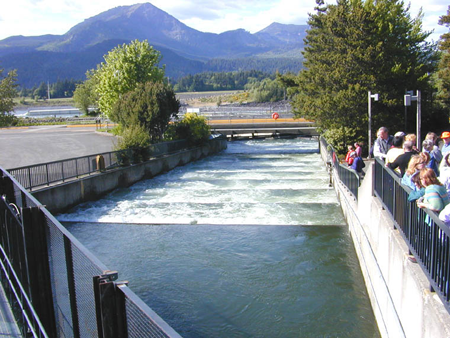
Salmon would often shoot straight up the ladder. But at times they would sit at the bottom for days on end. Nobody knew why.
In groups, research the wild salmon to find out why they swim up rivers and what it must be ike for them. Find out as much as you can about the journey and how it ends.
Now learn as much as you can about fish ladders, what they do, how they work, where they are built. Take a look at one if there are any near your school. One of the best-known in Scotland is at Pitlochry but there are others.
Now imagine you are one of the salmon headed upstream. Try to get inside the salmon's head and feel what it feels. Don't take this too far - the water's cold at this time of year.
Are you there? Can you imagine it? Now write a paragraph explaining why you stay at the bottom of a fish ladder for days on end, instead of shooting straight up it.
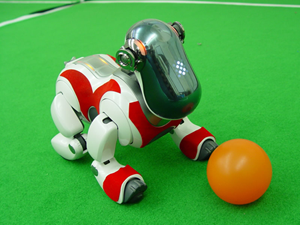
You could have robot goldfish as pets. If you put a solar cell in them they could swim around on your desk forever.
Suppose you had plenty of money, lots of engineering knowledge and a well-equipped laboratory.
You decide to build a really clever robot.
Why? What will it look like? What are you going to do with it?
Write a page.
Want more?
1. RoboSalmon - what he's made of and what's inside him.
2. How you get from real salmon to RoboSalmon and how much detail you include.
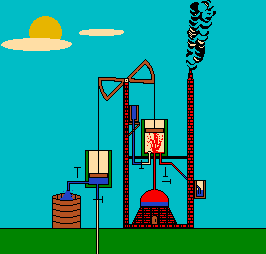
3. Paper on the Design and Construction of the Submersible Hybrid Autonomous Rover Craft (SHARC).
4. The modern world began at Glasgow University and efficiency was what it was all about. Sound far-fetched? Take a look at James Watt, Joseph Black, steam engines and the Industrial Revolution. Watt was asked to work on a model Newcomen steam engine when he was instrument maker at the University. Discussions of the science of heat with Black and his own engineering ability and curiosity led Watt to improvements in efficiency that meant steam engines could be used for machines in factories, not just to pump water out of mines. That was the beginning of the Industrial Revolution.
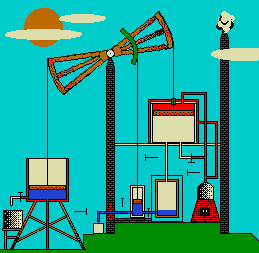
You can see the engine that began it all at the Hunterian Museum.
5. Still on efficiency, you might like to do some research and find out which is the most efficient machine for getting around. It might surprise you - or maybe not.
4. Biomimetics at National Geographic and in architecture.
5. Nice poster on AUV research at Southampton University that sums up the issues and future directions.
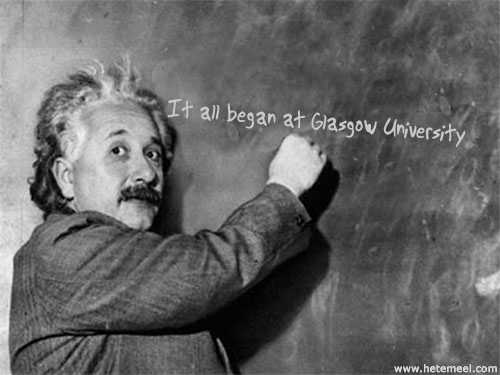
6. Robotic fish.net
7. How fish swim.
8. Fish and vortices. Fish as efficient machines using vortices.
9. Robotic fish at Caltech.
10. Essex robot fish video.
11. London robot fish and again.
12. NMRI robot fish.
13. Coelocanth videos.
14. Vortex images.


